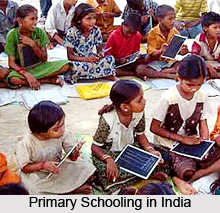 Elementary education in India is the foundation for the development of every citizen. The elementary education is also an important thing for the overall improvement of India. The Indian government has made the elementary education till class eight compulsory for every child. The schooling starts at the age of six. The government has made ample provisions for those in need of proper facilities. There are government schools that provide free of cost education to the needy. Making elementary education in India available for all has been a goal for the government since the eighth five-year plan.
Elementary education in India is the foundation for the development of every citizen. The elementary education is also an important thing for the overall improvement of India. The Indian government has made the elementary education till class eight compulsory for every child. The schooling starts at the age of six. The government has made ample provisions for those in need of proper facilities. There are government schools that provide free of cost education to the needy. Making elementary education in India available for all has been a goal for the government since the eighth five-year plan.
Indian government has launched a number of programmes for spreading elementary education in India, including the District Primary Education Programme (DPEP) of 1994. The new programme launched by the Indian government for elementary education in India, is the "Sarva Shiksha Abhiyan" or SSA, in 2001. All the programmes are aimed at universalising and improving the quality of elementary education in India through community ownership of elementary education. The Panchayati Raj institutions, School Management Committees, Village and Urban Slum Level Education Committees, Parents` and Teachers` Associations, Mother Teacher Associations, Tribal Autonomous Councils and other grassroots level structures, have also been involved in the elementary education system in India.
The main objective of elementary education in India is to make education accessible to children and ensure that they continue with their studies. The Indian government is providing textbooks and other to children from special focus groups, for facilitating development of elementary education in India. In fact, universal access, universal retention and universal achievement, are the main three objectives of elementary education in India, at the moment.












